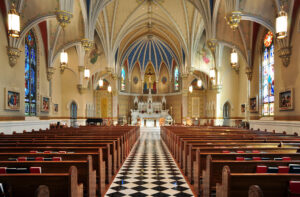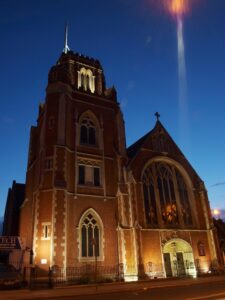In this tip sheet, you will discover foundational information to help you interact with Roman Catholic Christian leaders. It is part of a set of tools and training for FEMA to help disaster response professionals engage with faith communities. Much of the information also can help students, researchers, government agencies, non-profits and businesses learn about and develop relationships with communities. Click here for the PDF version for this tip sheet.
Religion Called: Roman Catholicism or Catholicism
Adherents Consider Themselves: Christian and are called Roman Catholics or Catholics
House of Worship: Church, Cathedral, or Basilica
First Point of Contact: Senior parish priest a.k.a. pastor
Religious Leader: Priest or Deacon
Spoken Direct Address: Use “Father” or “Deacon” or “Brother”/”Sister” for monks/nuns
Physical Interaction: Handshake O.K. across genders
HOUSE OF WORSHIP
- Churches are local houses of worship. A parish refers to the congregation of a particular church.
- Parishes often have non-sacred spaces such as multipurpose rooms, schools, gyms, or offices.
- Cathedrals and Basilicas are large centers of worship for an entire regional area run by a Diocese or Archdiocese.
- Monasteries and convents house monks and nuns (respectively), and may include a chapel and areas for instruction/work.
RELIGIOUS LEADERS
Ordained/Commissioned/Licensed Leaders
- Roman Catholic leadership is hierarchical. Ordained leadership roles are limited to men. Women can serve as nuns, sisters, or have other leadership opportunities.
- A Pope is the international head; under certain circumstances, his pronouncements are considered infallible.
- Regional leadership falls to archbishops and bishops who lead the Archdiocese or Diocese.
- Priests and deacons provide sacramental and spiritual leadership at all levels; many are in charge of a local parish.
- Cardinals are priests (usually bishops) specially designated to become part of an advisory council (“college”) to the Pope.
- Monsignor is an honorific title conferred upon some priests.
- Catholic leadership also includes many monks and nuns.
Holy Orders and Lay Leaders
- Brothers and Sisters are non-ordained (lay) leaders who have usually taken a vow of poverty, celibacy, and obedience and often live an active vocation of both prayer and service.
- Some U.S. parishes have lay administrators who perform many of the duties and take on many of the roles that once were the exclusive domain of clergy.
POINTS OF CONTACT
- Local: Parish, led by a priest and staff. Oversight may fall entirely to the pastor and his staff; or in many cases a pastor will consult with an elected parish council of lay community members. Approximately 75% of U.S. parishes have a parish council. First point of contact should be with the senior parish priest who has ultimate authority over parish resources.
- Regional: Diocese/Archdiocese, led by a Bishop, Archbishop or Cardinal.
- National: U.S. Conference of Catholic Bishops under the jurisdiction of the Pope.
NVOAD MEMBERSHIP AND CORE CAPABILITIES IN DISASTER
National Voluntary Organizations Active in Disaster (NVOAD) is a nonprofit, nonpartisan, membership-based organization that serves as the forum where organizations share knowledge and resources throughout the disaster cycle. FEMA DSA team members should check with their VAL to determine whether local or regional VOADs exist in their operational area. National VOAD members include:
- Catholic Charities USA
- Society of St. Vincent DePaul
ETIQUETTE QUICK TIPS
Greeting
When introducing yourself to a religious leader, use formal religious titles unless instructed otherwise. Brother/Sister [Last Name], Deacon [Last Name], Father [Last Name] OR Father. (Or Monsignor, Bishop/Your Excellency, Archbishop/Your Grace, Cardinal/Your Eminence).
Physical Interaction
In approaching Roman Catholic leaders, gestures common in the U.S. such as shaking hands are generally acceptable. It is also acceptable for men and women to shake hands. Hugging/embracing are much less common and should be avoided.
Other
When entering a Roman Catholic church, cathedral, basilica or other sacred space, shoes are generally left on but men should remove hats or caps. These spaces are considered sacred 24 hours a day – not only when they are being used. Responders should treat sacred spaces with respect and deference and refrain from certain behaviors such as eating, drinking, talking loudly, touching objects, or entering certain areas without permission. Visitors should wear conservative clothing covering the shoulders and knees. Stand when a priest enters the room and remove hats or caps. Ask before participating in worship services and do not take communion unless you are Roman
Catholic. Ushers can help with customs, dress, and etiquette.
GOVERNANCE / JUDICATORY
- Holy See/Vatican: Global headquarters for Roman Catholicism, with leadership centralized in the Roman Curia (College of Cardinals) headed by a supreme pontiff, commonly called the pope. Located in Rome, Italy.
- U.S. Conference of Catholic Bishops: Seat of administration for U.S. Catholics nationally. Its offices are in Washington, D.C., and it is accountable to Rome.
- Archdioceses and Dioceses: Administrative districts led by a bishop, who oversees local parishes in a geographical area.
- Some Roman Catholic institutions and orders fall outside the supervision of these bodies of governance, such as monastics who answer to a monastic order that in turn answers to Rome.
MEETING LOGISTICS AND SCHEDULING
Scheduling and Holidays
Catholic churches observe the Sabbath each week with Masses on Sundays and often on Saturday nights. Avoid scheduling meetings Saturday evenings, Sundays and around the following holidays:
- Christmas: a celebration of birth of Jesus as God Incarnate.Ash Wednesday: the beginning of the Lenten season, a 40-day period before Easter focused on self-examination, fasting
and penance in preparation for Easter Day observance. - Ash Wednesday: the beginning of the Lenten season, a 40-day period before Easter focused on self-examination, fasting and penance in preparation for Easter Day observance.
- Holy Week: week before Easter; begins with Palm/Passion Sunday (recalling Jesus’ return to Jerusalem); includes Holy Thursday (recalling Jesus’ institution of the practice of Holy Communion during his last meal with his disciples) and Good Friday (recalling Jesus’ crucifixion).
- Easter Sunday: the most important point in the Christian year celebrating the resurrection of Jesus from the dead.
- Pentecost: commemorating the receipt of the Holy Spirit by the nascent Christian community, fifty days after Jesus’ Resurrection; considered the birthday of the Church.
Food
In general, there are few dietary restrictions for Roman Catholics. Many Roman Catholics do take very seriously laws of fasting and abstinence, refraining from eating meat on certain days and limiting the quantity of food on other days. During the season of Lent, many Roman Catholics abstain from eating meat on Fridays, but may eat fish.
Logistics
The senior priest/Pastor of a parish has ultimate authority within the parish on spiritual, financial, and administrative decisions. They may be assisted by a business manager or parish associate who oversees the day-to-day operation of the parish and answers to the Pastor. It is important to foster a relationship and buy-in with the manager, as they often know the inner workings of the parish even if they do not hold the title of authority and power. The parish secretary is often a key contact.
DRESS
Roman Catholic dress is usually a combination of culture and ethnicity, not religious requirement. Lay Roman Catholics do not wear distinctive clothing but may wear religious medals or a crucifix on necklaces. When not engaged in a Mass or formal event, Roman Catholic priests, including Bishops and Archbishops, usually wear black pants and dress shirts, with a distinctive white tab collar and sometimes a black suit jacket. During religious events, parish priests normally wear robes called albs, Ushaped sashes worn around the neck called stoles, and sometimes a decorative robe-like outer layer called a chasuble. However, it is not uncommon in some places and situations to see priests in regular street clothing. Some monks and nuns wear distinctive identifying garments (robes and habits).
ABOUT CHRISTIANITY: ROMAN CATHOLICISM
In the U.S., Roman Catholics make up about 25 percent of the entire population and number about 78.4 million. Although U.S. Roman Catholics come from varying backgrounds, the group increasingly identifies as Latino or Hispanic. As a whole, the Church is experiencing growth in many regions, predominately in the Southwest and West Coast.
Roman Catholicism is a monotheistic Christian religion that believes Jesus Christ – who was both human and God – died to save all people from their sins. Central to the religion is the belief in the Holy Trinity, or the fact that God is omnipresent in three beings – the Father, the Son (Jesus Christ), and the Holy Spirit. Catholics believe that Jesus is the Son of God, conceived by
the power of the Holy Spirit and born to a virgin human mother named Mary. Other key beliefs include:
- Belief in apostolic succession (direct, continuous descent of leadership from Jesus’ apostles to the present), in the headship of the Pope in Rome, and in the threefold ministry of bishops, priests, and deacons.
- Emphasis on the necessity and efficacy of seven Holy Sacraments, including baptism, Eucharist, prayers for the sick, marriage, confirmation, confession/penance, and holy orders/ordination.
- Belief in transubstantiation, the notion that during the ritual of the Eucharist, the elements of bread and wine become the actual body and blood of Christ.
- Emphasis on the veneration of Mary, the Mother of Jesus, and of the saints.
Click here for the PDF version for this tip sheet.
The Engaging Faith Communities tip sheets were created through a collaboration between the DHS Center for Faith-based and Neighborhood Partnerships, the USC Center for Religion and Civic Culture, USC CREATE and the National Disaster Interfaiths Network. For further training, please see EMI course IS-505, which was also developed by this partnership.



